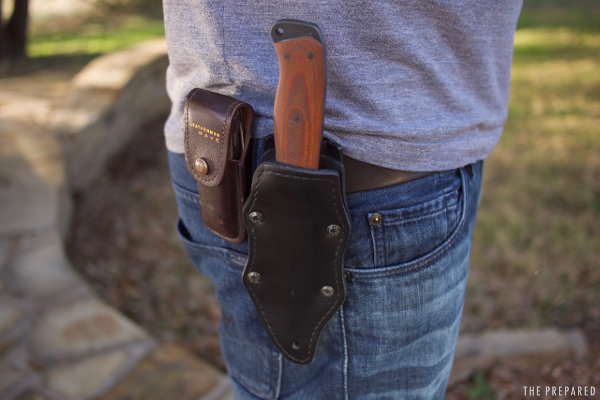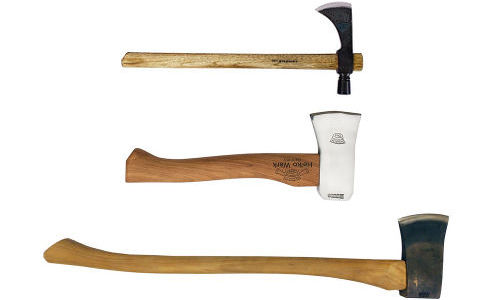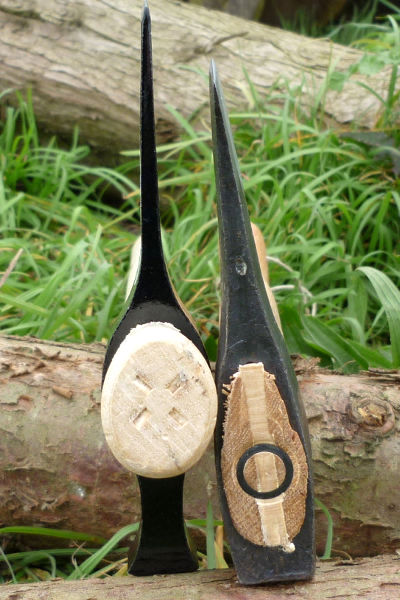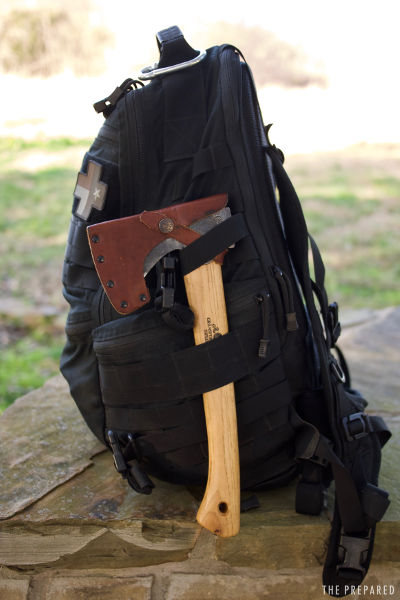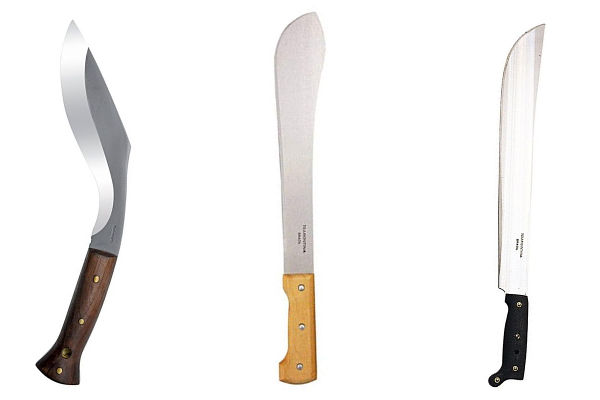You know you should have one or more bladed tools on hand to cut, chop, dig, and destroy things in an emergency. But it can be confusing to understand what your total kit should look like, axes vs. hatchets vs. tomahawks, which tools are right for which emergencies, if a large Bowie knife is redundant with a machete, and so on. The endless internet debates about “the ultimate SHTF blade” certainly don’t help, either.
This guide explains the important differences between the major categories of bladed tools and how you can decide which ones to mix and match in your preps.
We organize bladed survival tools into these buckets:
- Multi-tools: small enough for a pocket, like the classic Swiss Army Knife.
- Pocket knives: small folding knives for everyday carry.
- Field knives: fixed-blade knives under six inches, sometimes called “camp” or “survival” knives.
- Big fighting knives: knives that are too big to be considered a proper field knife, like the KA-BAR or Bowie knives, that are better suited for fighting and Rambo fantasies.
- Jungle knives: bladed tools used in hotter climates, namely machetes, kukris, and bolos.
- Axes: includes “normal” axes, hatchets, and tomahawks.
- Saws: folding saws, fixed-blade saws, pocket chain saws, powered chain saws.
- Combo “survival tools”: difficult-to-categorize Frankenstein mashups of various pieces from the rest of this list.
- Swords, katanas, etc.: No. Bad prepper, go to your room! You’re not Michonne and you won’t play her in the apocalypse.
Regardless of the specific emergencies you’re thinking about preparing for, we recommend that everyone has at least one each of these four primary edged tools (roughly in order of importance):
- Field knife
- Multi-tool
- A “big chopper” from the axe or jungle knife families
- Folding saw
The first two items are the most essential, and some people choose to stop there because that’s good enough to cover the majority of average situations.
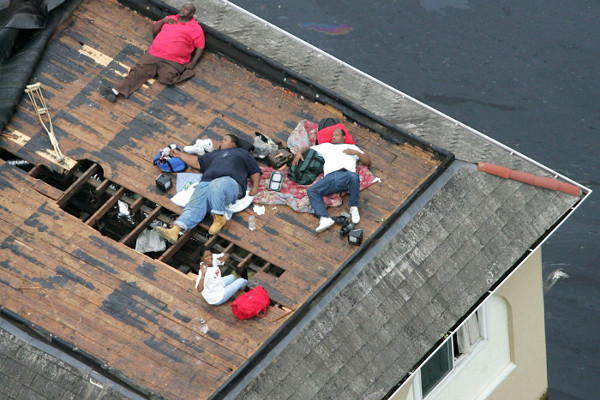
But the second two are not far behind. For example, when I was working in rescue shelters the first days after Hurricane Katrina, I met a number of different families who only survived because they had an axe on hand to break through a ceiling to escape the rising flood waters.
Making choices based on your location and storage
Where you live and how you organize your gear can affect what kinds of tools and mixes you use. While some of it boils down to personal preference and budget, it’s worth taking a moment to think through the big picture.
Hurricane Katrina is a good example. I grew up and learned bushcrafting in the Louisiana bayou. If I were in those pine woods and could only have one or the other, I would rather have a $20 machete (a jungle knife) than a $200 hatchet.
That’s because the closer you get to the equator, the softer natural wood and vegetation become. Chopping an old-growth hardwood forest in Minnesota is different than clearing your way through dense scrub brush on the Gulf Coast or southwestern desert.
If you live in those southern regions, that knowledge might cause you to pick a jungle knife instead of an axe for one of the core four tools. That wouldn’t be a wrong decision — but it’s not the best decision.
A jungle blade isn’t going to punch a hole in your roof when escaping hurricane flood waters, nor will it quickly destroy an old piece of furniture for firewood and other important tasks better suited for axes.
If I were still living in Louisiana, I’d keep a larger axe in my home supplies and a machete in my bug out bag. Not only does that cover all my bases, it fits gracefully into the model of where I store different gear and what they’re meant for.
We make recommendations based on your environment in each of the separate tool articles. For example, we pick shorter, demolition-style axes with synthetic/metal handles for those living in cities, while people in rural areas should have longer wood-handled forest axes.
Reviews:
- Best field knives
- Best multi-tools
- Best hand saws
- Best axes
- Best hatchets
- Best tomahawks
- Best machete and kukri jungle blades
- Best Bowie knife and other large fighting knives
- One blade to rule them all?
- Thinking about your blade mix
- Companion blades in the field
- The core workhorses: multi-tools, pocket knives, and field knives
- Axe vs. hatchet vs. tomahawk
- Jungle knives are a great compliment in hot climates
- Avoid very large tactical knives
- Saws round out your blade mix
- Combo survival tools are hit or miss
One blade to rule them all?
Carrying one thing is better than carrying multiple things, right? Less to pack, less to buy, less to train with! Isn’t it enough to spend $100 on a great field knife and be done with it?
The real question is, “enough for what?” There’s a wide, unpredictable range of things you might need to do during or after an emergency where a blade is critical. For example:
- Sectioning or cleaning downed limbs and trees for firewood and shelter construction
- Cutting down small trees and branches
- General food preparation
- Cleaning wild game or fish
- Medical (even surgery)
- Clearing brush for a camp or trail
- Forcing your way into locked buildings, vehicles, and containers by prying and chopping
- Demolishing furniture and building materials to use for firewood or to construct a shelter or barricade
- Breaking through doors and rooms that have been damaged by an earthquake, flood, or explosion (e.g. to rescue yourself or someone else, scavenge for supplies, or shelter in place)
- Light digging (e.g. for a latrine or cache)
- As a backup weapon to a gun, spear, or club
It is possible to do all of those activities with only a great 5” fixed-blade field knife. Some very experienced survivalists can even do most of the above with just a multi-tool or pocket knife. But you’re (probably) not an expert with thousands of hours of practice.
Some preppers have a strict mindset of finding The One Thing That Does Everything. We honestly wish it worked that way. But it just doesn’t. At best you can optimize for one thing that covers 50-80% of what you might need.

Most types of blades can do most types of activities. You can theoretically shave your face with a sword, prepare food with an axe, or cut down a tree with the small saw in your Swiss Army Knife.
But do you want to?
The right blade makes each of the above tasks so much easier, quicker, and safer. Especially under difficult conditions when you might be rushed for time, fatigued, hurt, relying on untrained people around you to help, working in awkward angles, etc.
There’s also something to be said about putting all of your eggs in one basket — not very smart for prepping.
That’s why most seasoned preppers mix and match blades of different kinds.
Be prepared. Don’t be a victim.
Want more great content and giveaways? Sign up for The Prepared’s free newsletter and get the best prepping content straight to your inbox. 1-2 emails a month, 0% spam.
Thinking about your blade mix
Don’t get too caught up in optimizing the perfect blade mix. It’s impossible.
You’ll be fine as long as you read this guide and are thoughtful about your situation. So don’t stress too much, make a decision, and use that saved time to practice your skills.
It’s logical that smaller versatile tools (namely the multi-tool and pocket knife) are more often kept on your body as often as possible for everyday carry (EDC) before an emergency even happens, while the bigger or more specialized tools (like a two-handed axe) are kept at home or in a truck bed.
Bug out and get home bags (BOB and GHB) are somewhere in the middle: large enough to carry a hatchet, tomahawk, machete, or folding saw, but portable enough where we still care about weight and versatility.
It can get mind-numbing to think through all the different scenario combinations. For example, if you always have your multi-tool everywhere you go, does that mean your get home bag (which is often kept in a car trunk) could use that money and space for a hatchet instead of a second multi-tool?
Keep the Sane Prepper Rules in mind and resist the urge to double-dip your gear unless you’re on a tight budget. You might keep a folding saw in your car, for example, and it’d be easy to think “well if I am at home, that means my car is at home, so that folding saw counts for the home gear too!” But you might abandon your car and leave that gear behind just to get home in a crisis.
Examples of popular blade mixes
Very basic:
- EDC: Multi-tool
- BOB: Field knife
Basic:
- EDC: Pocket knife
- BOB: Field knife + multi-tool
- GHB: Multi-tool
Middle:
- EDC: Multi-tool
- BOB: Field knife + multi-tool
- GHB: Field knife + folding saw
- Home: Axe
Advanced:
- EDC: Multi-tool
- BOB: Field knife + multi-tool + folding saw
- GHB: Field knife + multi-tool + hatchet
- Home: Axe
Luxury:
- EDC: Multi-tool
- BOB: Field knife + multi-tool + kukri
- GHB: Field knife + multi-tool + hatchet
- Home: Axe + saw
The power of “companion” blades in the field
Your field knife or multi-tool is the most common workhorse in an emergency. You’ll likely have it on your body or in your pack whenever you’re outside your home.
Many pack-weight-conscious preppers stop there — the field knife and multi-tool combo is the max they’ll carry on foot. It’s fine if you choose to stop there, too.
But many soldiers and survivalists augment the field knife with a larger companion blade of some kind that’s also constantly carried on their person or pack, because that extra weight, costly as it is, gives them a massive boost in capabilities with heavier tasks like chopping, fighting, and destruction.
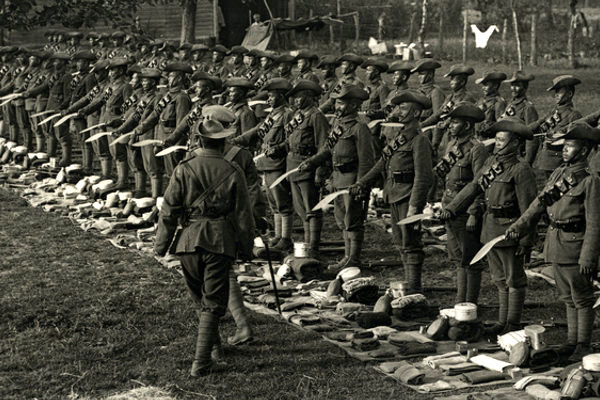
This “field knife plus larger companion blade” pair is found in many eras and world cultures: the Sami people of the Arctic Circle had the puukko and leuku, the Nepalese the karda and kukri, Canadian trappers the skinner and hatchet, and the Japanese samurai the tanto and kiridashi.
History bears out the power of this little + big combination, which is why preppers should give it serious consideration, despite the fact that it does add some extra weight to your load out.
Prep for what’s in front of you, not a theoretical future
Blade selection is one of those topics where people frequently break an important Sane Prepper Rule: Prep first and foremost for the situations you’re more likely to encounter.
If you live in a city, for example, you need to optimize for the immediate aftermath in the days after a disaster instead of what things will be like months later once you’ve made it to your bug-out cabin in the Canadian Rockies and things settle into a post-collapse “new normal.”
In that scenario, you may need to hack through sheetrock and plumbing to rescue a friend in a damaged building, or open a locked door or window to get supplies, or break apart industrial crates for shelter material.
So you’ll want an axe that’s easy to store and effective in small spaces for these immediate demolition and B&E (breaking and entering) needs — not a heavy axe that’s optimized for chopping large forest trees into a winter’s worth of firewood.
The core workhorses: multi-tools, pocket knives, and field knives
These small, portable, versatile tools tend to be the core foundation for any prep. They are the tools you’ll use most often in daily life and emergencies.
That’s why most people carry them on their body almost all of the time (typically in a pocket or belt holster), and why minimalists who challenge themselves to survive with only a handful of gear typically include one or two of these types.
Although popular, we think of pocket knives as a nice-to-have accessory, not a primary choice for prepping, for two main reasons:
- The knife blade on a multi-tool might be 20% worse at “knife things” than a pocket knife, but the extra functionality makes it 200% more useful overall in roughly the same size.
- There’s no contest between a pocket knife and a field knife for survival tasks. A single piece of hardened steel with a five inch blade will always be better than a three inch hinged (thus weak) blade when digging, prying, chopping, etc.
The field knife isn’t always the best tool for the job, but it can usually get ‘er done. It’s fine if you set up your gear to keep the field knife in your bag, but try to have a sheath that works with belts or MOLLE rigs so that you can keep the knife on your body if things get really bad.
The modern multi-tool’s amazing flexibility in such a small and relatively-affordable package makes it a very close second to the field knife in importance. Multi-tools are just one of those ‘no-brainer’ prepper picks that doesn’t require a lot of deep theory to justify.
Other than the various gadgets for random chores in daily life, like a screwdriver head or nail file, one of the biggest emergency values is the small saw blade.
TV personality Les “Survivorman” Stroud actually prefers the multi-tool over the field knife — if he can have only one tool — specifically because it combines a saw blade and a knife blade into one package. He has a level of expertise to overcome the limitations of a multi-tool knife and finds the combo useful in the bush.
Axe vs. hatchet vs. tomahawk
The punchline: We generally recommend some form of an axe for everyone, including those who live in a city. As a supplement to or replacement for the axe, you’d choose a hatchet if you want portable wilderness survival or a tomahawk if you care about close-quarters fighting and demolition. Both the tomahawk and hatchet might be overridden by a jungle blade if you live in very warm climates.
A wedge-shaped mass at the end of a handle has been with humanity for millennia because it does one thing better than any other tool: chops into hard material and splits it apart with minimal effort.
Although similar enough to be considered siblings, the difference between an axe, tomahawk, and hatchet boils down to small changes in size, blade head shape, and purpose:
- Axe: Least portable, most destructive power, best at processing wood, uses two hands
- Hatchet: A mini one-handed axe that trades destructive power for portability and versatility
- Tomahawk: Built for fighting, breaching, and throwing with one hand
Tomahawks — originally a Native American melee weapon adopted by frontier trappers and traders — have had a renaissance amongst bushcrafters, preppers, and even some corners of the military in recent years.
The tomahawk’s cutting edge is typically shorter than that of a hatchet, making it less effective as a chopper and not as good of a substitute for a field knife. But it penetrates more deeply, hence its popularity as a weapon and demolition tool.
The main advantage the classic tomahawk has over the hatchet is its field-replaceable handle. The hatchet in the picture above has a circular wedge driven into it to expand the top of the handle and hold it on, but the tomahawk to its left has no wedge and is held on its round, straight, easy-to-make handle by a simple friction fit.
However, tomahawks are a specialized tool that most people should probably skip, unless they’ve really done their homework and know that it’s a good fit. Similar to pocket knives, ‘hawks can be a blast to use and display, but for most preppers they’re a nice-to-have accessory that doesn’t override the other choices.
Note: You should never throw a blade in a fight. It’s dumb, doesn’t work, and now the bad guy has your weapon. Leave the theatrics to the movies, Chief Internet Ninja.
Check out our best tactical tomahawk review if you want one anyway.
The axe vs. hatchet decision is mostly about power vs. portability. A small axe is about 19 inches versus a large hatchet at about 16 inches. Hatchets are small enough that many people carry them on their belt when in the field.
Even a small hatchet is meaningfully better at processing wood than a large knife. For many modern American and European bushcrafters, as well as the trappers and Northwoods pioneers of frontier America, the hatchet hits the sweet spot between compactness and chopping power.
The two aren’t mutually exclusive, however. Many of our experts keep a large axe at home to process firewood and other big tasks in the immediate area while keeping a hatchet in their bug out bag for times away from home.
There are deeper differences between axes and hatchets and their various models. For example, some head shapes are better for splitting man-made materials while others are better for natural growth.
Another difference is that hatchets are potentially more dangerous than axes. Using one hand instead of two gives you less control over the swing, and because the head swings closer to your body, there’s more risk you’ll accidentally injure yourself.
So read both reviews for the best survival axe and best survival hatchet. Your choice may come down to something as simple as the size or your hands.
Jungle knives are a great compliment in hot climates
This category is best summed up as “really large blades from hot or humid climates.”
Although similar to large knives, these blades are primarily designed to be tools, not melee weapons. The same advice applies here: Don’t buy one of these blades imagining you’ll be swinging it around zombies when SHTF.
There are many different names like bolo, kukri (sometimes khukuri), machete, and parang, which represent the local versions of roughly the same kind of blade that independently developed in various warm-climate cultures around the world.
These blades work really well in any type of natural environment where you’re not chopping hardwood for fire and shelter.
So the pine forests of the American Southeast, the swamps of the Gulf Coast, the deserts of the American Southwest, and the Mediterranean or Caribbean are all environments where you might consider carrying a machete or kukri instead of a compact axe or hatchet.
Avoid very large blades
This one’s easy: Don’t carry a large fixed blade over six inches instead of a more manageable field knife, machete, hatchet, etc. unless you have a valid reason.
One of the few valid reasons we’re aware of: Many military vets used the classic 7” USMC KA-BAR knife while on duty in the 1940-80’s. It’s a great blade that lasts a lifetime. So if you still have yours and you’re comfortable using it, continue on and Semper Fi.
Rambo and Crocodile Dundee fantasies, or a desire to find The One Blade To Rule Them All, are not valid reasons.
There’s a primeval but deceptive magic in holding an exquisitely-crafted large blade. We’ve seen many people who should know better fall under that spell.
Such a simple, balanced weapon feels like an extension of your body. It makes you feel like you instantly have capabilities that, in reality, you can’t actually unlock without some training.
Fighting with big blades is an art that requires study and practice to equal (much less surpass) the crude combat effectiveness of simpler tools like clubs, spears, smaller stabbing knives, and axes in untrained hands. Subtleties like angle of attack and grip at the moment of impact make the difference between a cut and glancing blow — these are things that only training will give you a feel for.
Some people choose a big knife because they think it’s a “field knife on steroids” that will handle every possible task. “Why would I carry a five inch knife when I can have an eight inch one?”
We find that blades over six inches get too unwieldy for the average person without adding any tangible benefit for the kind of core survival tasks a field knife is meant for. Those few extra inches don’t really change the kinds of trees you can cut down or how easy it is.
Vice versa, a very large knife is nowhere near as effective at processing wood and vegetation as a hatchet or jungle blade.
Saws round out your blade mix
The saw on a multi-tool is good enough for minor tasks. But more preppers are adding a quality folding saw to their main bug out bag because it compliments the slicing and chopping motions of other tools, finishing a “complete” set of tools that can handle almost anything.
Although in the same category, this guide ignores the kind of standard fixed-blade saws and powered chainsaws you’d find at Home Depot. It’s great if you have them around — a powered chainsaw with extra fuel can be a massive help cleaning up after a natural disaster — but we don’t think of them as core preps because they rely on fuel, are too big, have too many complex parts that can break, etc.
Some preppers consider a folding saw a luxury and plan to use a big chopping blade for all their wood processing chores in a disaster. We think that’s a mistake:
- A saw is just plain safer than any chopper, by an order of magnitude. You’re not swinging a sharp object, with chips flying into your (probably unprotected) eyes.
- A saw requires far less skill to use than an axe or similar tool, so you can use it while injured, or you can hand it to a child.
- Sawing is gentler on the material you’re working with than chopping, and you can more easily cut through an object without breaking or splitting it.
- A hacksaw blade can cut things that no other edged tool can hope to get through, like metal pipes. So if you have a saw with a few different types of replaceable blades, you’re ready for anything.
You’ll also run across “pocket” chain saws that are often branded as survival or prepper saws in stores like Amazon. It’s effectively the same chain you’d use on a powered chainsaw, but with handles on each end of the chain so you can manually run it back and forth in a sawing motion.
Unfortunately, these pocket saws are not effective enough to be worth it. For essentially the same price, space, and weight, you can cover your bases much better with a combo of a multi-tool and a hatchet or folding saw.
Combo survival tools are hit or miss
Many new preppers go on Amazon or to a trade show, see a “14-in-1 survival tool” that seems to do all kinds of stuff from felling trees to starting a fire and making coffee, buy it, then regret it as soon as they use it in the field.
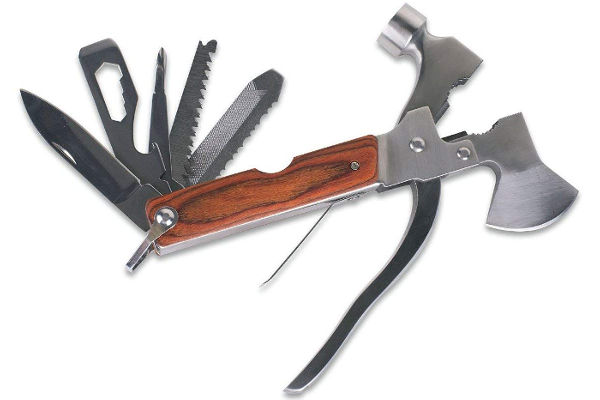
Many (most?) of the products in this category are junk that only exist for the company to make a quick buck. That’s why most of them are under $30 and Amazon is flooded with fake reviews.
We do love the idea of a quality hatchet or axe with a detachable or folding saw in the handle, or some other combo that saves space and money.
But due to the amount of junk in this market, we’re not recommending any combo products until we’ve done enough deep field reviews to be comfortable that there are at least a few options better than having the separate, proper, time-tested tools above.

